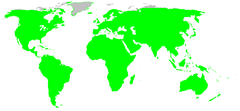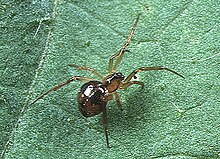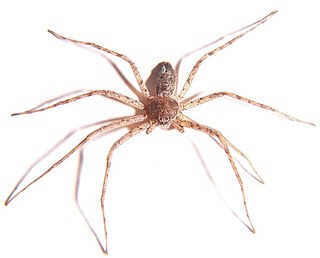
Philodromidae, also known as philodromid crab spiders and running crab spiders, is a family of araneomorph spiders first described by Tord Tamerlan Teodor Thorell in 1870. It contains over 500 species in thirty genera.

Orb-weaver spiders are members of the spider family Araneidae. They are the most common group of builders of spiral wheel-shaped webs often found in gardens, fields, and forests. The English word "orb" can mean "circular", hence the English name of the group. Araneids have eight similar eyes, hairy or spiny legs, and no stridulating organs.

Oonopidae, also known as goblin spiders, is a family of spiders consisting of over 1,600 described species in about 113 genera worldwide, with total species diversity estimated at 2000 to 2500 species. The type genus of the family is OonopsKeyserling, 1835.

Linyphiidae, spiders commonly known as sheet weavers, or money spiders is a family of very small spiders comprising 4706 described species in 620 genera worldwide. This makes Linyphiidae the second largest family of spiders after the Salticidae. The family is poorly understood due to their small body size and wide distribution; new genera and species are still being discovered throughout the world. The newest such genus is Himalafurca from Nepal, formally described in April 2021 by Tanasevitch. Since it is so difficult to identify such tiny spiders, there are regular changes in taxonomy as species are combined or divided.
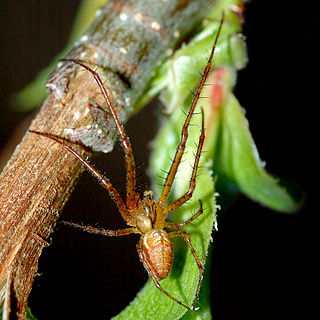
Long-jawed orb weavers or long jawed spiders (Tetragnathidae) are a family of araneomorph spiders first described by Anton Menge in 1866. They have elongated bodies, legs, and chelicerae, and build small orb webs with an open hub with few, wide-set radii and spirals with no signal line or retreat. Some species are often found in long vegetation near water.

Corinnidae is a family of araneomorph spiders, sometimes called corinnid sac spiders. The family, like other "clubionoid" families, has a confusing taxonomic history. Once it was a part of the large catch-all taxon Clubionidae, now very much smaller. The original members of the family are apparently similar only in that they have eight eyes arranged in two rows, conical anterior spinnerets that touch and are generally wandering predators that build silken retreats, or sacs, usually on plant terminals, between leaves, under bark or under rocks.

Scaffold web spiders or cave cobweb spiders (Nesticidae) are a family of araneomorph spiders closely allied with tangle-web spiders (Theridiidae). Like the Theridiidae, these spiders have a comb of serrated bristles on the hind tarsi that are used to pull silk bands from the spinnerets. Nesticidae contains 16 genera and about 300 species, many of which are associated with caves or overhangs. The genus Nesticus is the type for the family and is found throughout the world. The related Eidmannella has speciated considerably in Texas caves and includes some extremely localized species that are considered threatened. One species, Eidmannella pallida, is found in caves and under overhangs, but also in agricultural fields and other habitats away from such restricted areas. The genus Carpathonesticus is found in central Eurasia.

Theridiosomatidae, commonly known as Ray Spiders, are a family of araneomorph spiders first described by Eugène Simon in 1881. The family includes 137 species divided between 20 genera. They are most recognizable for their construction of cone-shaped webs.

Theridiosoma is a genus of ray spiders that was first described by Octavius Pickard-Cambridge in 1879. They use their web as a high speed slingshot to actively hunt for prey.

Ochyroceratidae is a six-eyed spider family, with 165 described species in ten genera. They are common inhabitants of caves and the tropical forest litter of South Africa, the Caribbean, Asia and South America. Considered an ecological counterpart of the Linyphiidae of the northern temperate zone, species are especially diverse in the Indo-Pacific region.

Argyrodes, also called dewdrop spiders, is a genus of comb-footed spiders that was first described by Eugène Louis Simon in 1864. They occur worldwide, and are best known for their kleptoparasitism. They can spin their own webs, but tend to invade and reside in their hosts' webs. This relationship can be commensal or even mutual if the dewdrop spider feeds on small trapped insects that are not eaten by the host. Some species can even prey upon the host.

Theridion is a genus of tangle-web spiders with a worldwide distribution. Notable species are the Hawaiian happy face spider (T. grallator), named for the iconic symbol on its abdomen, and T. nigroannulatum, one of few spider species that lives in social groups, attacking prey en masse to overwhelm them as a team.
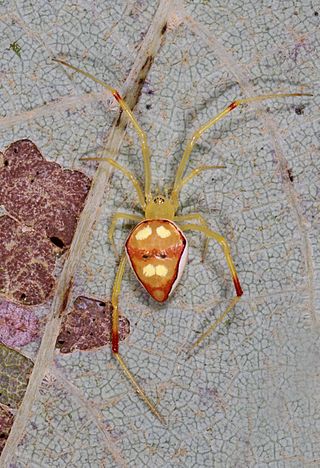
The spider genus Spintharus occurs from the northeastern United States to Brazil. Nicholas Marcellus Hentz circumscribed the genus in 1850, initially as a monospecific genus containing his newly described species S. flavidus.

Anelosimus is a cosmopolitan genus of cobweb spiders (Theridiidae), currently containing 74 species. Anelosimus is a key group in the study of sociality and its evolution in spiders. It contains species spanning the spectrum from solitary to highly social (quasisocial), with eight quasisocial species, far more than any other spider genus. Among these is the South American social species Anelosimus eximius, among the best studied social spider species.

Euryopis is a genus of comb-footed spiders that was first described by Anton Menge in 1868.

Lasaeola is a genus of comb-footed spiders that was first described by Eugène Louis Simon in 1881. The type species was described under the name Pachydactylus pronus, but was renamed Lasaeola prona when it was discovered that the name "Pachydactylus" was preoccupied. Both this genus and Deliana were removed from the synonymy of Dipoena in 1988, but many of these species require more study before their placement is certain.

Dipoena is a genus of tangle-web spiders that was first described by Tamerlan Thorell in 1869.

Rhomphaea is a genus of comb-footed spiders that was first described by Ludwig Carl Christian Koch in 1872.

Thymoites is a genus of comb-footed spiders that was first described by Eugen von Keyserling in 1884.

